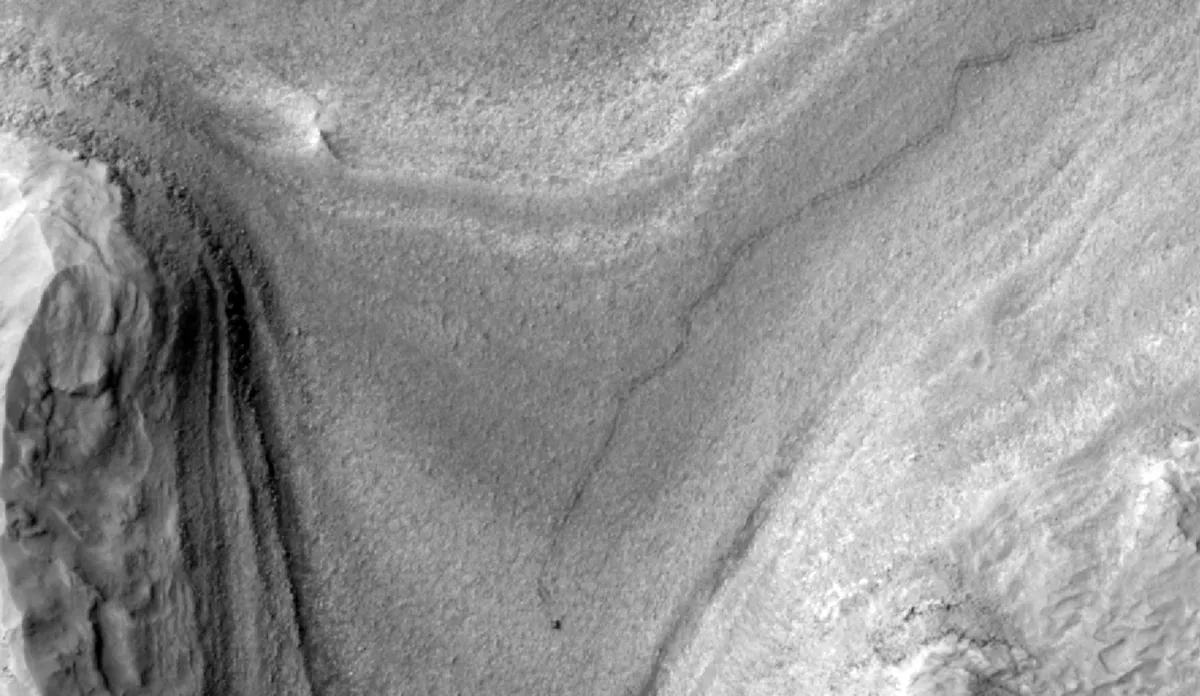
Nasa's Curiosity rover has achieved a remarkable milestone by capturing its first-ever mid-drive photograph from orbit. This groundbreaking image was taken by the HiRISE camera aboard the Mars Reconnaissance Orbiter and showcases Curiosity navigating the rugged Martian landscape while leaving a distinctive trail of tracks behind. The rover is heading towards a unique region that holds the potential to unveil evidence of ancient groundwater activity.
On February 28, during the 4,466th Martian day, or sol, of its mission, Curiosity was photographed in what is believed to be the first-ever orbital image of the rover actively driving across the Red Planet. This high-resolution image, captured by the HiRISE (High-Resolution Imaging Science Experiment) camera, shows the rover as a small dark speck at the front of a long trail of tracks stretching approximately 1,050 feet (320 meters). These tracks are expected to remain visible for several months, marking about 11 separate drives that began on February 2, as Curiosity traverses from the Gediz Vallis channel towards its next scientific target — a region thought to contain intriguing “boxwork” rock formations, possibly formed by ancient groundwater activity billions of years ago.
The speed at which the rover reaches its next scientific destination depends on various factors, including the rover's software navigation and the complexity of the terrain. Engineers at Nasa’s Jet Propulsion Laboratory (JPL) in Southern California, which leads Curiosity's mission, collaborate with scientists to meticulously plan each day's journey. Doug Ellison, Curiosity’s planning team chief at JPL, noted, “By comparing the time HiRISE took the image to the rover’s commands for the day, we can see it was nearly done with a 69-foot drive.”
The HiRISE camera is designed to deliver optimal spatial resolution, capturing the majority of the scene in black and white, with a strip of color down the center. Although HiRISE has previously captured Curiosity in color, this particular image shows the rover within the black-and-white portion. In this snapshot, Curiosity's tracks lead up to a steep slope, which the rover has since ascended. It is anticipated that Curiosity will reach its new scientific location within the next month.
Nasa's Curiosity rover is a car-sized robotic explorer tasked with studying the geology, climate, and potential habitability of Mars. Built at Nasa’s Jet Propulsion Laboratory (JPL) — managed by Caltech in Pasadena, California — Curiosity has been investigating the Red Planet since its dramatic landing in 2012. As part of the broader Mars Exploration Program, the rover contributes vital insights into Mars' ancient environment, paving the way for future human missions.
On the other hand, Nasa’s Mars Reconnaissance Orbiter (MRO) has been in orbit around Mars since 2006, employing its suite of powerful instruments to study the planet's atmosphere, surface, and subsurface layers. Operated by JPL for Nasa’s Science Mission Directorate, MRO plays a crucial role in supporting the Mars Exploration Program by relaying data for surface missions and capturing high-resolution imagery. One of MRO's key instruments, the HiRISE camera, operated by the University of Arizona and built by BAE Systems in Boulder, Colorado, has provided some of the most detailed views of Mars ever obtained from orbit.